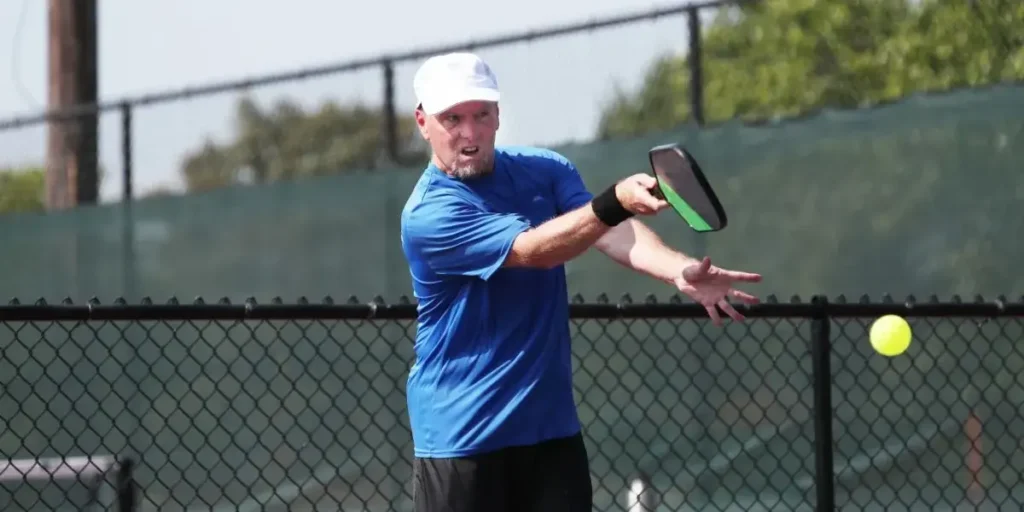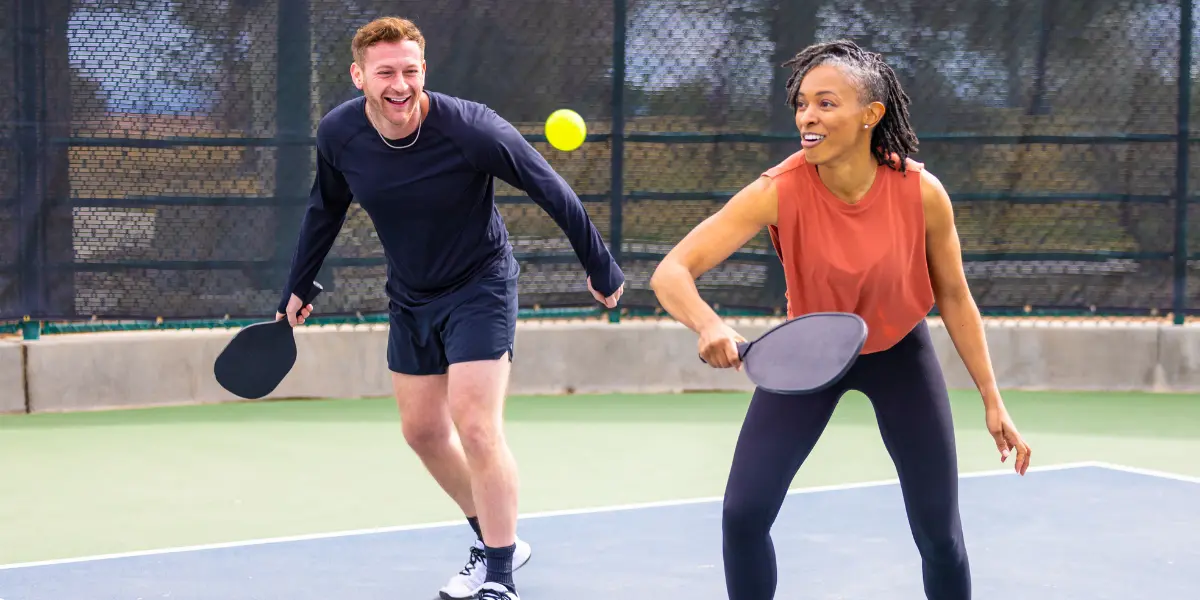A fast-moving rally, a quick reflex, and suddenly—the ball strikes you. What now? Do you lose the point, or does the play continue? Many players, especially those new to pickleball, are often unsure about the rules when the ball makes contact with a player. The answer depends on various factors, such as whether the ball bounced first, if it hit your paddle hand, or if it struck an opponent.
The USA Pickleball Association (USAPA) has clear regulations outlining what happens when a ball hits a player. Some situations result in an automatic fault, while others allow play to continue.
In this guide, we’ll break down all possible scenarios to ensure you understand how these rules apply in a match and how to avoid unnecessary faults.
What Happens If the Ball Hits You in Pickleball?
In pickleball, the general rule states that if the ball hits a player before bouncing, it is considered a fault against that player, and the opponent automatically wins the rally.
However, if the ball has already bounced on the court before hitting a player, the rally continues as usual. The player can attempt to return the shot, or if the ball goes out of bounds afterward, the point is awarded accordingly.
The only exception to this rule is when the ball hits a player’s paddle hand (below the wrist), which is considered part of the paddle and is legal.
This rule is designed to ensure fair play and prevent players from intentionally using their bodies to interfere with the game.
What Happens if Pickleball Touches Your Clothing or Hair?
Many players wonder whether touching the ball with their clothing or hair results in a fault.
According to official rules, if the ball makes contact with any part of a player’s body, including their clothing or hair, before bouncing, it is considered a fault against that player. This means their opponent automatically wins the rally.
However, if the ball first bounces on the court and then touches a player’s clothing or hair, the game continues. The point is only lost if the ball did not hit the ground first. To avoid unnecessary faults, players should stay alert and ensure they position themselves effectively to avoid accidental ball contact.
Can You Hit a Pickleball with Your Hand?
If the ball makes contact with a player’s hand below the wrist while they are holding the paddle, it is considered part of the paddle, and the shot is legal. Play continues as if the ball had been struck with the paddle itself. This is an important rule, as many players may instinctively use their paddle hand to block or return a shot.

However, if the ball touches any part of the arm above the wrist, it is considered a fault, and the opposing player is awarded the point. Players are not allowed to intentionally use their hands to hit the ball, as this would provide an unfair advantage and go against the sport’s standard rules.
What Happens If You Hit Your Opponent in Pickleball?
Is It a Fault If You Hit Your Opponent?
If a ball in play strikes an opponent before bouncing, the rally ends immediately, and the point is awarded to the player who hit the ball. This is because the opponent’s body is considered an extension of the court, and if the ball does not land in bounds first, it results in an automatic fault for the player who was struck.
However, if the ball first bounces on the ground and then deflects off an opponent, play continues as normal. The opponent is expected to return the shot or allow it to go out of bounds, just as they would in any other rally situation.
What If the Ball Deflects Off an Opponent’s Paddle or Body?
There are situations where the ball might hit an opponent’s paddle first and then deflect onto their body. In such cases, the rally remains in play, provided the opponent still has a chance to return the shot. If they fail to do so, the point is awarded to the player who struck the ball.
However, if the ball directly strikes an opponent’s body before making contact with their paddle, it is considered a fault against the opponent, and the player who hit the shot wins the rally.
While accidental ball contact is a part of the game, deliberately aiming at an opponent is considered unsportsmanlike.
In competitive settings, repeated instances of intentional body shots may result in warnings or penalties. Players should focus on strategic shot placement rather than relying on hitting opponents as a tactic.
What If a Pickleball Serve Hits You?
Serving is a crucial part of pickleball, but sometimes the ball may hit a player before the rally even starts. The outcome depends on who gets hit and when it happens.
If a serve hits the receiver before bouncing, it’s a fault against them, and the serving team wins the point. This rule ensures the receiver is ready and does not interfere with the ball’s trajectory.
If the ball strikes the serving player or their partner before crossing the net, it’s a serving fault, resulting in a lost serve. This prevents accidental self-inflicted contact from affecting play.

Another case is when a serve clips the net and then hits the receiver. If it lands in the correct service box first, the rally continues. Otherwise, it’s a fault against the receiver.
Knowing these rules helps players avoid losing points unnecessarily due to ball contact.
Does It Matter Where the Ball Hits You?
Different parts of the body affect the outcome when a ball makes contact. Understanding these distinctions can help players react appropriately.
Ball Hitting the Foot or Leg
If the ball hits a player’s foot or leg before bouncing, it is a fault, and the opponent wins the rally. The player’s body is considered an extension of the court, meaning any direct contact before a bounce results in a point loss. However, if the ball bounces first and then strikes the player’s leg or foot, play continues as normal.
Ball Hitting the Chest or Shoulder
Similar to foot or leg contact, if the ball hits a player’s chest or shoulder before bouncing, it is an immediate fault. The opponent is awarded the rally because the ball did not land legally on the court first. If the ball bounces on the court and then makes contact with a player’s upper body, the rally continues.
Ball Hitting the Paddle Hand
A key distinction in pickleball is that the paddle hand (below the wrist) is considered part of the paddle. If the ball makes contact with this area, it is a legal shot, and play continues. However, if the ball hits any part of the arm above the wrist, it is considered a fault.
How to Avoid Being Hit in Pickleball
While ball contact is sometimes unavoidable, players can take proactive steps to minimize faults:
- Maintain Proper Positioning: Staying alert to the ball’s trajectory can help players avoid standing in the direct path of shots, reducing the likelihood of getting hit.
- Wear Fitted Clothing: Loose clothing increases the risk of accidental ball contact, leading to unnecessary faults. Choosing well-fitted sportswear minimizes this risk.
- Improve Reaction Time: Quick reflexes and anticipation skills enable players to move out of the ball’s way more effectively, particularly in fast-paced rallies where decisions must be made in split seconds.
- Be Mindful of Net Play: Close-range exchanges can be unpredictable, so maintaining controlled movement near the net prevents accidental contact.
By following these strategies, players can enhance their awareness, minimize unintentional ball contact, and maintain better control during matches.
FAQs
No, double hits are not allowed unless they occur in a single continuous motion. If the ball is intentionally struck twice in separate movements, it results in a fault.
If the ball clips the net and then hits a player before bouncing, it is still considered a fault against the player who got hit, and the opponent wins the point.
Conclusion
Knowing what happens if the ball hits you in pickleball is essential for playing the game fairly and competitively. The rules make it clear that ball contact can result in different outcomes depending on whether it strikes a player directly, after bouncing, or deflects off a paddle.
By understanding these distinctions, players can make informed decisions, avoid unnecessary faults, and maintain the flow of the game.
Following the USAPA guidelines ensures that players stay within the rules while enjoying a competitive match.
Whether you’re avoiding ball contact, reacting to accidental hits, or dealing with tricky scenarios, being knowledgeable about these rules enhances your confidence and performance on the court. A strong grasp of the regulations will not only prevent disputes but also contribute to a smoother and more strategic playing experience.

